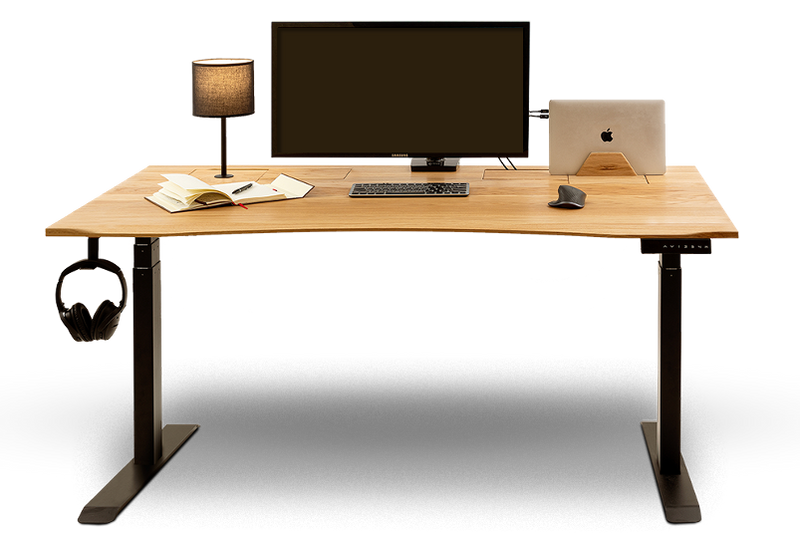Maintain Healthy Computer Posture: Tips for Correct Sitting Position
Throw your old, uninspiring, worn-out desk away and
configure your new ErgoHide desk today.
Maintaining the correct posture while using a computer is crucial in preventing back, neck, and wrist pain. Even though many workplaces require sitting for long hours, you don't have to suffer from chronic pain. Check if you are sitting correctly by following the guidelines below.
Ensure proper sitting posture. Most office chairs have adjustable backrests and seats, and some even have lumbar support. With the availability of various types of office chairs with more or fewer adjustments, use the instructions below to achieve the correct posture while sitting:
- Thighs should rest on the chair seat.
- Maintain a 90-degree angle between the thighs and lower legs.
- Keep a 90-degree angle between the feet and lower legs, with the feet resting flat on the floor.
- The back should be inclined at an angle between 100 and 135 degrees relative to the thighs.
- Arms should rest beside the body.
- Shoulders and neck should be relaxed, with shoulders back and chest open.
- Ensure the keyboard and mouse are within reach without stretching the arms or twisting the shoulders.
- The computer screen should be at a comfortable viewing angle, without straining the neck or eyes.
- Ears, shoulders, and hips should be aligned vertically.
What to consider for the correct computer posture?
Find a neutral pelvic position for proper sitting.
Maintaining the correct posture while using a computer requires a neutral pelvic position with the buttocks resting against the chair backrest.
But how do you find a neutral pelvic position?
Place your hands under your buttocks and locate the most prominent bones in your buttocks. Once you find them, round the lumbar region of your back into a slightly flexed position and tilt your pelvis forward. With this movement, you should feel a flatter area between the pelvic bones on your hands. Then tilt the pelvis forward in the opposite direction and shift all the weight to the back of your thighs.
The neutral pelvic position is in the middle between these two positions. The pelvic bones will feel more pointed when in the neutral position.
Distribute the weight evenly on both hips and avoid leaning to one side while sitting. Crossing and twisting the legs is a significant temptation during long periods of sitting, but it is a bad habit. Twisting strains the spine and can lead to problems such as sprains, spinal strains, and herniated discs. Moreover, crossing the legs worsens blood circulation.
Avoid protruding the head forward
Regularly check that you are not protruding your head forward. Protruding the head and neck forward is a common problem when working with a computer, and it should be consciously avoided. For every centimeter the head is protruded forward, the neck is burdened with an additional 4.5 kilograms. This can result in various health issues such as neck and back pain, muscle spasms, restricted breathing, headaches, migraines, insomnia, fatigue, numbness, and tingling in the hands and palms.
Equipment setup for proper sitting and posture
Achieving the correct posture while using a computer requires arranging your equipment to suit your body. We have already discussed the correct height of standing or sitting desks in a previous article, and we have also calculated the appropriate chair height and computer screen height. The best choice for maintaining proper posture is an adjustable desk due to its height customization options. Alternatively, choose a desk that suits your body height.
Check all the possible adjustments of your office chair. If your chair has lumbar support, adjustable armrests, or any other type of additional support, adjust them as needed. You can also remove elements such as armrests and cushions if they hinder your posture. If your feet do not reach the floor, consider using a footrest or a similar tool to elevate your feet. If your back is not aligned and supported by the chair's backrest, use a lumbar support.
Position the computer screen at an arm's length, approximately 45-60 cm away from your head. The upper third of the screen should be at eye level. Incorrect screen positioning strains the neck and eyes excessively and can lead to neck strain, herniated discs, and headaches.
Position the screen to minimize or eliminate glare and reflections. Place it perpendicular to windows and adjust curtains or blinds if necessary.
For proper arm posture, adjust the height of the armrests so that your elbows are at a 100-110 degree angle. With an upright posture, the keyboard should be slightly tilted, and the hands should be slightly lower than the elbows. Keep your wrists aligned and minimize up and down bending.
A keyboard holder can be helpful for maintaining proper hand and wrist posture as it facilitates achieving the correct angles. Use the keyboard rest as needed when not typing. Do not use the wrist rest while typing, as twisting the wrists can strain them. It is recommended to use keyboard shortcuts to reduce mouse usage.
Keep your phone within reach, but avoid holding the handset with your shoulder. Instead, use headphones or a speaker.
Take breaks from sitting at the computer
Take regular breaks from sitting and stretch your body. Breaks should be taken at least once an hour, preferably every 30 minutes. Stand up from your chair and move around during these breaks. This will alleviate existing pain and prevent muscle stiffness and the development of new pains.
Try simple stretching exercises to relieve and stretch your muscles and improve blood circulation. For those experiencing back pain, squats are an excellent exercise. Doing squat stretches for 15 minutes a day maintains the curvature of the lumbar spine, reduces spinal compression, and helps improve hip mobility.
The eyes also need breaks during computer work. To prevent eye fatigue, look at something distant (at least 6 meters away) for 20 seconds every 20 minutes. Blue light filter glasses can also be helpful.
In addition to the eyes, the wrists are also at risk during computer work. Stretch them by extending your arm in front of you and bending your fingers backward with the help of your other hand. You can also squeeze a tennis ball for wrist stretching.
Throw your old, uninspiring, worn-out desk away and
configure your new ErgoHide desk today.
Want to know why? Because with ErgoHide you:
Will change the way you work: Unique cable management solution for a clutter free space and unique add-ons that will reflect your personal style.
Will transform your office into a space of inspiration and beauty: Each of ErgoHide desks is crafted from certified and locally sourced solid oak or walnut wood. Every tabletop is hand-oiled and personally inspected before sending, ensuring long-lasting durability, timeless style, and the natural beauty of the wood.
Will support a local EU company and our sustainability mission: Learn more on our About Us page, but in short – we take a hands-on approach to sustainability. For every 100 desks sold, we plant a tree to help replenish the natural resources we use.
You are always on the safe side with us: Our 180-day money-back guarantee even applies to custom-sized desks and special requests, giving you plenty of time to test your ErgoHide desk before making your final decision.
Choose your ideal setup and take advantage of FREE delivery – click here to start configuring your new ErgoHide desk now!

 Real wood
Real wood
 Cable management
Cable management
 Add-ons
Add-ons
 Epoxy LED
Epoxy LED



















